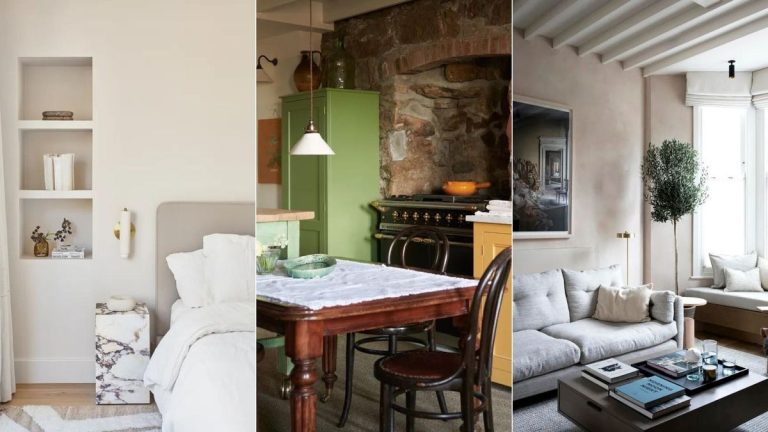The 1990s will forever be my favorite decade, but even I have resisted reinventing it with some of the bygone design trends. Those who remember everything about this era – purple bedrooms, honey oak kitchens, chrome plating – are probably rather glad that it's a thing of the past. Well, the 1990s are back, but this time they've been reinvented for 2024, and the new interpretation has impressed even me.
Here, I'm taking inspiration from my favorite decade, the 1990s, to talk about my current favorite interior design trends for 2024.
1990s Interior Design Trends New Ways
There are some nostalgic trends that have faded from memory, but like most decorating trends, there are others that have come full circle and are now more popular than ever. In fact, many of this year's most prolific trends are inspired by the past – the 1990s to be exact. Let's walk down memory lane with me…
1. Minimalism
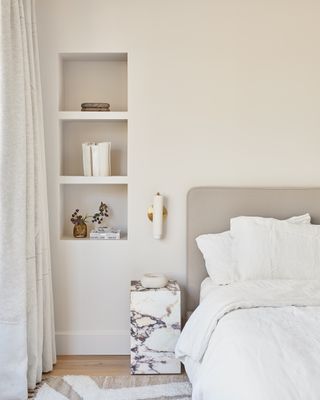
(Image credit: Renee Kemps)
After an era of excess and luxury in the 1980s, the 1990s saw many of us embrace pared-down, minimalist decorating ideas. But far from the stark atmosphere of the past, today's pared-back aesthetic means spaces that are less sterile and more relaxed.
Expected to dominate interior design in 2024, warm or soft minimalism blends warm color schemes with clean, simple lines and style. It's an easy-to-live aesthetic that's a huge evolution of the quiet luxury trends and traditional minimalism themes that have been a staple of our trend coverage over the past year or so. We value careful attention to furniture selection, a focused color palette based on earthy, natural tones, and a hint of the richness of reflections that certain hard materials provide.
“We call it essentialism, or soft minimalism,” says Kasper Ron von Lotsbeck of the Danish studio Noam Architects. “We believe that connecting with nature is important for human well-being. These days, many people miss it in their lives. Unlike the stark minimalism of the 90s, Our minimalism focuses on using materials that activate the senses: when you walk on a wooden floor, you hear your footsteps; when you walk on a soft carpet, you feel cozy and warm. It's not really minimalist – we use embellishments sometimes – but it's always done in an essential and considered way.
2. Stainless steel and chrome finish
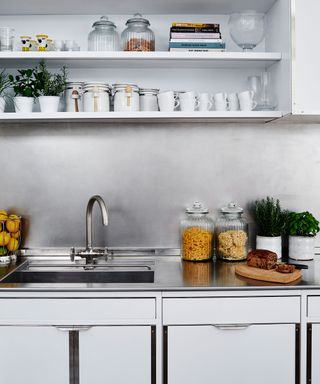
(Image credit: Alison Henry / Officine Gullo)
In the 1990s, cool metal was everywhere, from light fixtures and furniture legs to kitchen backsplashes and hardware. After 30 years, the chrome decoration trend is back. I expect this trend to continue for the long term.
Chrome's resurgence in popularity is an exciting prospect for interior designers who are once again using this cool metal to design spaces.
“We are excited to see the return of chrome and metallic details,” say John and Christine Gachot, co-founders of GACHOT Studios. Chrome was commonly used in the '90s, when it was considered a modern material to subtly reference mid-century modern design, and was the pinnacle of fashion. ”
Stainless steel is also making a welcome comeback this year. David Beckham's stainless steel kitchen is at the top of our desire list.
“Stainless steel is the ideal backsplash material for modern times because it is durable, low-maintenance, and highly hygienic,” said Tom Edmonds, design director at Lewis Alderson. I am. “You can create large, intricate pieces with welded sinks and drainers, virtually eliminating joints where bacteria and dirt can accumulate.” Although often associated with modern kitchens, , the stainless steel and chrome finish pairs surprisingly well with traditional cabinetry. “In a classic kitchen, stainless steel gives it a modern edge, and over time it develops small swirl marks that settle into a beautiful mellow patina with little effort,” adds Tom.
3. Color blocking
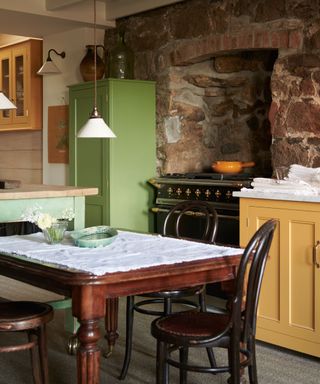
(Image courtesy of deVOL Kitchens)
Beige may have been the go-to color in the '90s, but color blocking was another color trend that made waves during this time. First popularized by his 1980s fashions of bold, primary, bright colors, this decade saw dripping and blocking of color become commonplace in homes up and down the United States. This season, we're drawn to the color in all its vibrant glory and pairing it with unexpected combinations to create a contemporary home that's vibrant and not outdated.
Color blocking is a great technique for people who want to test strong colors without going overboard. In modern homes, an all-over approach is popular, with blocks of primary colors, often in conflict. But if you want a more classic look, choose one small, well-defined block of dramatic color. Make your statement color more impactful by limiting the rest of your paint job to muted tones. Best of all, a small injection of saturated color is easy to update.
4. Oak kitchen cabinets
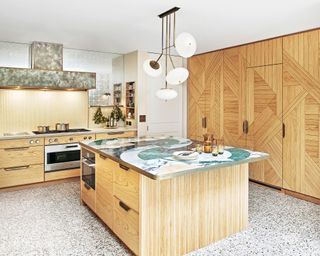
(Image credit: Ledbelly Studio)
Oak kitchen cabinet ideas, especially honey oak and golden oak, were common in 90s kitchens and offer a warm, safe and traditional look.
As a child, I have fond memories of our kitchen being made of what I called “orange wood.” Unfortunately, it was demolished in the early 2000s and replaced with modern stained beech wood. However, honey and golden oak are making a comeback in modern times. In recent years, some new and interesting techniques have emerged that have revitalized this material and made this old classic a modern favorite.
Oak kitchens are now considered to be eternally stylish, and designs using sustainably produced or reclaimed wood are more popular than ever. What has changed is the design of the oak kitchen cabinets. Fluting, unusual textured finishes and inlays are now at the forefront of kitchen trends.
5.Beige
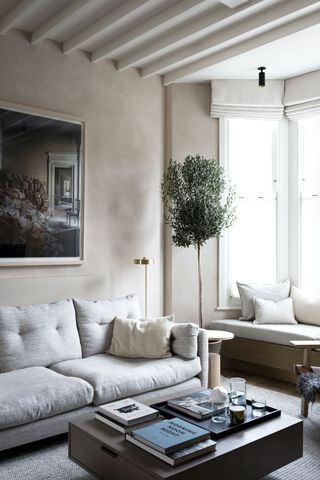
(Image provided by: TR Studio)
The magnolia and beige color scheme was popular in the 90s. You can't move without seeing a wall of magnolia, or the occasional lilac. These days, decorating with beige is back and better than ever. Gone is the standard decorator and builder beige, once the butt of many jokes. A popular choice right now is what we call the “new neutrals.”
Many people are rediscovering the power of this earthy, neutral material to create calm, tranquil and nurturing interiors. New neutral colors inspired by nature have an inherently calming effect, eliciting the same reaction you get when looking out at a beautiful country or seascape.
Ditching the '90s concept of magnolia hues, new neutrals are inspiring and grounding. “I love the tranquility that comes with a neutral palette in a room, especially if you're trying to recreate a quiet, luxurious aesthetic,” says interior designer Tamsin Johnson. But this choice doesn't have to mean boring. By layering different tones such as off-white and beige, and introducing various caramel and black accents, you can create an interesting and exciting space. ”
Neutrals are generally easy to use and blend with almost any other color. This means you don't have to be an expert to find the perfect room color ideas for your home.
Our affinity for certain looks, materials, and colors has a lot to do with our personalities, environments, and experiences, so whether it's back on trend or not, home decor that will make you happier in your home It is important to choose ideas.

